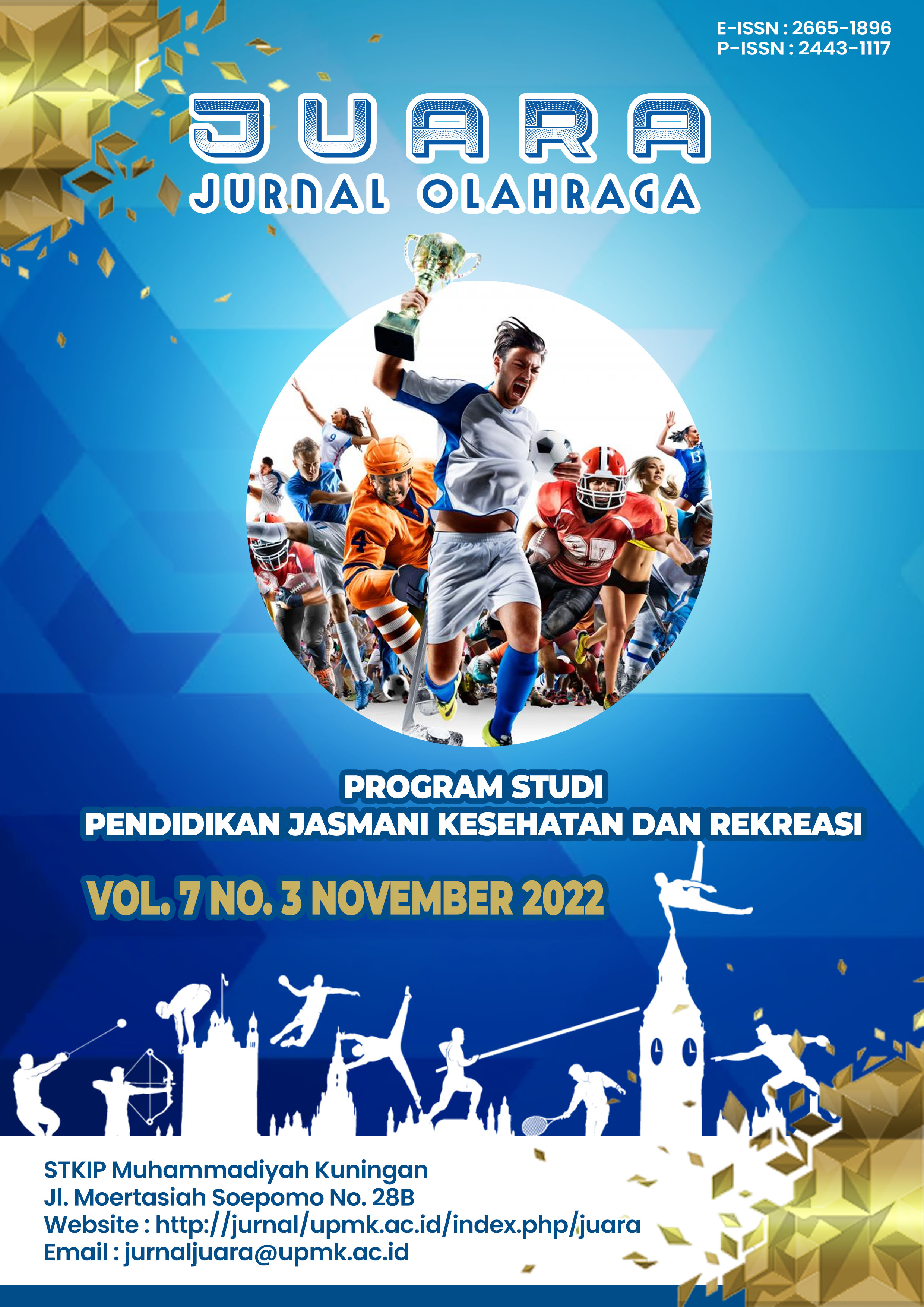Abstract
This study aims to determine the application of contextual approach-based animation media in Physical, Sport, and Health Education (PJOK) learning for fourth-grade elementary school students. This research is a development method that refers to the ADDIE model. ADDIE development research consists of five stages, namely (1) Analysis, (2) Design, (3) Development, (4) Implementation, and (5) Evaluation. The data analysis technique of this research uses the results of the review of learning content experts, learning design experts, and media experts in the form of input, feedback, criticism, and suggestions for improvement contained in the questionnaire and the percentage score. The results showed that the learning animation media based on the contextual approach PJOK for fourth-grade elementary school students produced learning products suitable for the learning process. Thus, this study concludes that by learning resources using animated media based on a contextual approach, students are more enthusiastic by having a high interest in learning.
References
Agus, Rachmi, Marssheilla, Fahrizqi, Bagus, Eko, Yuliandra Rizki, Gumantan, A. (2021). The Learning Motivation and Physical Fitness of University Students During the Implementation of the New Normal Covid-19 Pandemic. JUARA: Jurnal Olahraga, 6(1). https://doi.org/https://doi.org/10.33222/juara.v6i1.1184 The
Aryanti, S., Hartati, & Syafaruddin. (2020). Learning of badminton model through animation video on physical education students. International Journal of Human Movement and Sports Sciences, 8(6), 47–50. https://doi.org/10.13189/saj.2020.080708
Atiles, J., & Pinholster, L. (2019). Student Teaching: Reflections of a Relentless Journey. Journal of Early Childhood Teacher Education, 34(4), 308–319. https://doi.org/10.1080/10901027.2013.845632
Azzajjad, M. F., Tendrita, M., & Ahmar, D. S. (2021). Effect of animation and review video making (arvima) in non-classical learning model on independent learning and students’ learning outcome. Linguistics and Culture Review, 5(S3), 967–976. https://doi.org/10.21744/lingcure.v5ns3.1657
Brownell, C. (2020). The Preparation of Teachers in Health and Physical Education. American Physical Education Review, 34(5), 278–280. https://doi.org/10.1080/23267224.1929.10652386
Chen, A., & Ennis, C. D. (2017). Goals, Interests, and Learning in Physical Education. Journal of Educational Research, 97(6), 329–339. https://doi.org/10.3200/JOER.97.6.329-339
Ge, Z. (2019). Does a mismatch between learning media preference and received learning media bring a negative impact on Academic performance ? An experiment with e-learners. Interactive Learning Environments, 0(0), 1–17. https://doi.org/10.1080/10494820.2019.1612449
Hartati, S. (2020). The Effectiveness of The Powerpoint Assisted SQ4R Model on Reading Skills In Class V Students. Journal of Education and Management Studies, 2, 1–4.
Hawkins, A. (2018). Pragmatism, purpose, and play: Struggle for the soul of physical education. Quest, 60(3), 345–356. https://doi.org/10.1080/00336297.2008.10483585
Hickey, A. (2020). Generation animation : participatory action research and intergenerational pedagogy Generation animation : participatory action research and intergenerational pedagogy. https://doi.org/10.1080/25741136.2020.1769952
Hobbs, R., Cabral, N., Ebrahimi, A., Yoon, J., & Al-Humaidan, R. (2019). Field-Based Teacher Education in Elementary Media Literacy as a Means to Promote Global Understanding. Action in Teacher Education, 33(2), 144–156. https://doi.org/10.1080/01626620.2011.569313
Kramtsova, E. E. (2019). Computer Graphics and Animation as a Formative Medium. Journal of Russian & East European Psychology, 35(3), 81–84. https://doi.org/10.2753/rpo1061-0405350381
Marvasti, A. (2018). Research methods. The Cambridge Handbook of Social Problems, 1(3), 23–37. https://doi.org/10.1017/9781108656184.003
Maryati, I. (2018). Improving Statistical Reasoning Ability of Junior High School Students Through Contextual Learning. Mosharafa: Jurnal Pendidikan Matematika, 6(1), 129–140. https://doi.org/10.31980/mosharafa.v6i1.300
Mulyani, F., & Haliza, N. (2021). Analysis of the Development of Science and Technology (Science) in Education. Jurnal Pendidikan Dan Konseling (JPDK), 3(1), 101–109. https://doi.org/10.31004/jpdk.v3i1.1432
Prabawa, I. K. R., Satyawan, I. M., & Spyanawati, N. L. P. (2021). Development of contextual based PJOK video game for grade 1 elementary school students. Jurnal Olahraga Pendidikan Indonesia (JOPI), 1(1), 11–26. https://doi.org/10.54284/jopi.v1i1.3
Rakiyah, S. (2019). The Impact of Animation Media on the Character of. Komunikologi: Jurnal Pengembangan Ilmu Komunikasi Dan Sosial, 3(1), 29–35.
Sala Ripoll, C., Oparka, R., Campbell, A., & Erolin, C. (2017). The cell cycle: development of an eLearning animation. Journal of Visual Communication in Medicine, 40(1), 13–20. https://doi.org/10.1080/17453054.2017.1289059
Selwyn, N., Eynon, R., & Potter, J. (2017). A decade of Learning Media and Technology: looking back and looking forward. Learning, Media and Technology, 42(2), 127–129. https://doi.org/10.1080/17439884.2017.1324483
Selwyn, N., & Oliver, M. (2019). Learning, media and technology: Looking backwards and moving forward. Learning, Media and Technology, 36(1), 1–3. https://doi.org/10.1080/17439884.2011.557916
Silva, R. C. A., e Silva, V. L. de F. F., & Silva, A. P. (2019). Distance learning for teaching in physical education. Moritz. Revista de Educacao Fisica, 25(1), 1–5. https://doi.org/10.1590/s1980-6574201900010002
Souto-Manning, M., & Price-Dennis, D. (2017). Critically Redefining and Repositioning Media Texts in Early Childhood Teacher Education: What If? And Why? Journal of Early Childhood Teacher Education, 33(4), 304–321. https://doi.org/10.1080/10901027.2012.732669
Sugandi, A. I., & Bernard, M. (2018). Application of Contextual Approach to Mathematical Comprehension and Communication Ability of Middle School Students. Jurnal Analisa, 4(1), 172–178. https://doi.org/10.15575/ja.v4i1.2364
Susanto, R. (2020). Contextual-Based Long Jump Learning in Grade V Elementary School Students. Physical Activity Journal, 2(1), 70. https://doi.org/10.20884/1.paju.2020.2.1.3287
Trout, J., & Christie, B. (2017). Interactive Video Games in Physical Education. Journal of Physical Education, Recreation & Dance, 78(5), 29–45. https://doi.org/10.1080/07303084.2007.10598021
Tutus Eshananda Hars, Hermawan Pamot, R. (2014). Learning Model of Physical Education Locomotor Basic Learning in Grade III Primary School. Journal of Physical Education, Sport, Health and Recreation, 4(2), 102–108. https://doi.org/10.1080/17408989.2020.1799967
Yeh, T. K., Tseng, K. Y., Cho, C. W., Barufaldi, J. P., Lin, M. S., & Chang, C. Y. (2019). Exploring the Impact of Prior Knowledge and Appropriate Feedback on Students’ Perceived Cognitive Load and Learning Outcomes: Animation-based earthquakes instruction. International Journal of Science Education, 34(10), 1555–1570. https://doi.org/10.1080/09500693.2011.579640
Zhu, X., Ennis, C. D., & Chen, A. (2017). Implementation challenges for a constructivist physical education curriculum. Physical Education and Sport Pedagogy, 16(1), 83–99. https://doi.org/10.1080/17408981003712802

This work is licensed under a Creative Commons Attribution-ShareAlike 4.0 International License.

